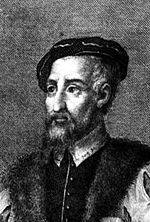Andrés Laguna
| Andrés Laguna | |
|---|---|

Andrés Laguna
|
|
| Born | 1499 Segovia |
| Died | 1559 Guadalajara |
| Nationality | Spain |
| Scientific career | |
| Fields |
botany pharmacologist |
Andrés Laguna de Segovia (1499–1559) was a Spanish humanist physician, pharmacologist, and botanist.
Laguna was born in Segovia, according to Diego de Colmenares and other historians, to a converted Jewish doctor. He studied the arts for two years in Salamanca, then moved to Paris in 1530, where he graduated from the arts and went on to study medicine. He also learned classical languages such as Greek and Latin with such fluency as to be able to read Dioscorides in his original language. He was also influenced by Erasmus. Laguna returned to Spain in 1536, then travelled to England, lived some years in the Netherlands and collected herbal remedies in all the places he stayed to verify Dioscorides's prescriptions. Between 1540 and 1545 he resided in Metz, becoming a doctor of the city, and from 1545 to 1554 he stayed in Italy, where he received a doctorate from the University of Bologne and was honored by the Popes Paul III and Julius III, becoming doctor to the latter pontiff. He was provided with accommodations in Venice by the Spanish ambassador Diego Hurtado de Mendoza, a preeminent humanist and proprietor of a nutritional library. Laguna finally returned to Spain in 1557, after another extended stay in the Netherlands lasting three years; he served as doctor to Charles V and Philip II. Lastly, he created the Botanical Garden of Aranjuez. He died, probably in Guadalajara, Spain, in 1559. His remains were interred in the church of San Miguel, in Segovia.
Laguna worked on literary, historical, philosophical, political (Europe the Self-Tormentor, that is to say, she miserably torments herself and laments her own disgrace) and medical subjects, as a typical homo universalis of the Renaissance. His most celebrated work is the translation into Castilian, with interesting commentaries and additions that double the original text, of Dioscorides's Materia Medica. His primary source was the edition translated to Latin by Ruelle and printed in Alcala in 1518 under supervision of Antonio de Nebrija, but also Ruelle's own classes, which he attended during his stay in Paris between 1530 and 1536. The work was published with the title Annotations on Dioscorides of Anazarbus (Lyon, 1554). He also indicates, in his translation, the errors committed by Ruelle that he noticed when collating the Latin translation with various Greek codices. He finished this annotation in Rome (1553) and one year later, on one of his visits to Venice, he produced a printing of his edition at the same place where P. Andrea Mattioli, the principal distributor of Dioscorides in Europe (he had made a translation to Latin and another to Italian in 1544 that was reprinted seventeen times), produced his own edition. Laguna personally verified all the prescriptions of Dioscorides and added his own observations, opinions and experiences as a botanist and pharmacologist who had experimented with herbs gathered in many areas of Europe and the Mediterranean coast. His translation is clear and precise and the commentaries constitute a primary source, not just for botanical medicine of the period, but for other scientific and technical activities. The text was reprinted in Antwerp in 1555 and was reprinted twenty-two times by the end of the eighteenth century; it was much more influential than other editions of Galen or Theophrastus in the European Renaissance, since the prescriptions of Dioscorides had a more practical nature.
...
Wikipedia
